- Biology Article
- Griffith Experiment Genetic Material

Griffith Experiment and Search of Genetic Material

The search for Genetic material started during the mid-nineteenth century. The principle of inheritance was discovered by Mendel. Based on his investigation, Mendel concluded that some ‘factors’ are transferred from one generation to another. Mendel’s Law of Inheritance was the basis for the researchers on genetic material. Keeping his conclusions in mind, scientists who came after him, focused on chromosomes in search of genetic material. Even though the chromosomal components were identified, the material which is responsible for inheritance remained unanswered. It took a long time for the acceptance of DNA as the genetic transformation. Let’s go through a brief account of the discovery of genetic material and Griffith experiment.
Griffith Experiment & Transforming Principle
Griffith experiment was a stepping stone for the discovery of genetic material. Frederick Griffith experiments were conducted with Streptococcus pneumoniae.
During the experiment, Griffith cultured Streptococcus pneumoniae bacteria which showed two patterns of growth. One culture plate consisted of smooth shiny colonies (S) while other consisted of rough colonies (R). The difference was due to the presence of mucous coat in S strain bacteria, whereas the R strain bacteria lacked them.
Experiment: Griffith injected both S and R strains to mice. The one which was infected with the S strain developed pneumonia and died while that infected with the R strain stayed alive.
In the second stage, Griffith heat-killed the S strain bacteria and injected into mice, but the mice stayed alive. Then, he mixed the heat-killed S and live R strains. This mixture was injected into mice and they died. In addition, he found living S strain bacteria in dead mice.
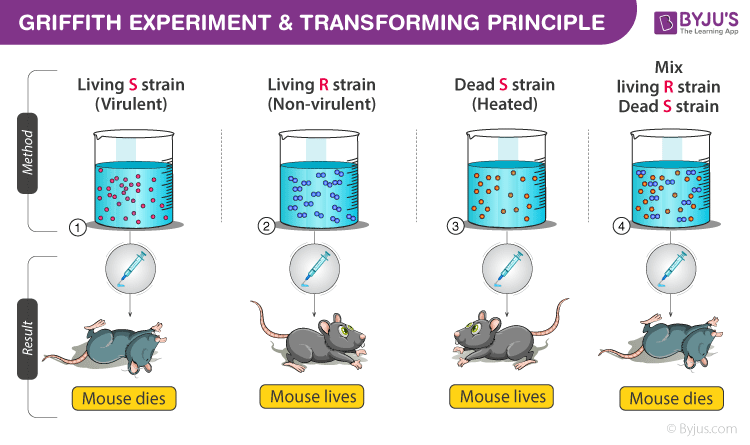
Conclusion: Based on the observation, Griffith concluded that R strain bacteria had been transformed by S strain bacteria. The R strain inherited some ‘transforming principle’ from the heat-killed S strain bacteria which made them virulent. And he assumed this transforming principle as genetic material.
DNA as Genetic Material
Griffith experiment was a turning point towards the discovery of hereditary material. However, it failed to explain the biochemistry of genetic material. Hence, a group of scientists, Oswald Avery, Colin MacLeod and Maclyn McCarty continued the Griffith experiment in search of biochemical nature of the hereditary material. Their discovery revised the concept of protein as genetic material to DNA as genetic material .
Avery and his team extracted and purified proteins, DNA, RNA and other biomolecules from the heat-killed S strain bacteria. They discovered that DNA is the genetic material and it is alone responsible for the transformation of the R strain bacteria. They observed that protein-digesting enzymes (proteases) and RNA-digesting enzymes (RNases) didn’t inhibit transformation but DNase did. Although it was not accepted by all, they concluded DNA as genetic material.
Frequently Asked Questions on Griffith Experiment
What was griffith’s experiment and why was it important.
Griffith’s experiment was the first experiment which suggested that bacteria can transfer genetic information through a process called transformation.
What is the conclusion of Griffith experiment?
The experiment concluded that bacteria are capable of transfering genetic information through transformation.
What was the most significant conclusion of Griffith’s experiments with pneumonia in mice?
The experiment conducted by Griffith found that bacteria are capable of transfering genetic information through transformation.
What did Frederick Griffith want to learn about bacteria?
Frederick Griffith wanted to learn if bacterial transformation was possible.
How did the two types of bacteria used by Griffith differ?
Griffith used two strains of pneumococcus (Streptococcus pneumoniae) bacteria: a type III-S and a type II-R.

Put your understanding of this concept to test by answering a few MCQs. Click ‘Start Quiz’ to begin!
Select the correct answer and click on the “Finish” button Check your score and answers at the end of the quiz
Visit BYJU’S for all Biology related queries and study materials
Your result is as below
Request OTP on Voice Call
Leave a Comment Cancel reply
Your Mobile number and Email id will not be published. Required fields are marked *
Post My Comment
Hi! This is well explained. I love it
Register with BYJU'S & Download Free PDFs
Register with byju's & watch live videos.
This page has been archived and is no longer updated
Discovery of DNA as the Hereditary Material using Streptococcus pneumoniae
No one could have predicted that experiments designed to understand bacterial pneumonia would lead to the discovery of DNA as the hereditary material. In the early part of the twentieth century, before the advent of antibiotics, pneumococcal infections claimed many more lives than they do today. Researchers on both sides of the Atlantic were thus actively engaged in studying Streptococcus pneumoniae , the bacterium responsible for clinical infections. Early on, it became apparent that multiple strains of S. pneumoniae were responsible for causing bacterial pnuemonia. Researchers also noted that patients developed antibodies to the particular strain, or serotype, with which they were infected, but these antisera were not universally reactive against pneumococcal strains. However, the bacterial isolates and serum samples from these clinical studies provided the critical reagents for the experiments that ultimately led to the identification of DNA as the hereditary material.
Pneumococcal Research Provides Critical Tools in DNA Research
Although numerous scientists engaged in pneumococcal research during the first half of the twentieth century, two of these researchers played an especially important role in the course of events that led to the discovery of DNA as the hereditary material . One of these individuals was Oswald Avery . Avery joined the Rockefeller Institute for Medical Research, now the Rockefeller University, in 1913 as part of a team seeking to develop a therapeutic serum for treating lobular pneumonia. Avery believed that knowledge of the chemical composition of the pneumococcus bacterium was essential for understanding and treating the disease . He perfected his biochemical technique by focusing on the chemical composition of the capsule that surrounded virulent S strains of pneumococci. In his early work, Avery helped establish that polysaccharides were a major component of the pneumococcal capsule and that capsules from different serotypes of pneumococci had distinctive polysaccharide compositions. Avery also concerned himself with the role of capsules in pathogenicity, as capsules were notably absent from the surface of nonvirulent R forms of streptococci. Defying the conventional wisdom of the time, Avery hypothesized that the polysaccharides in the capsules were the actual antigens stimulating the production of antibodies in infected patients (Avery & Goebel, 1933).
Purification of the Active Transforming Principle
When Avery first became aware of Griffith's results, he treated them with skepticism. Other researchers and laboratories, however, were quick to reproduce and build upon Griffith's data. Within a few years, Sia and Dawson (1931) showed that transformation could be carried out in liquid cultures of pneumococci as well as in mice, allowing more precise control of environmental variables in transformation experiments. In 1932, Alloway further demonstrated that the active transforming principle was present in sterile, cell-free extracts prepared from heat-treated pneumococci by filtration. These additional findings convinced Avery that the transforming principle could be identified, and he applied his considerable biochemical expertise to its purification from pneumococcal extracts (Avery et al. , 1944).
A critical aspect of any biochemical purification is the development of an assay, or a way to measure the activity of interest. For their experiments, Avery and his colleagues developed conditions under which R cells could be reliably transformed into S cells using extracts of heat-killed Type III S cells. These same conditions could then be used to measure transforming activity in fractions obtained at different steps in the purification process. To quantify the actual amount of transforming principle in a fraction, each sample was tested at a series of increasing dilutions. These data represent four identical experiments in which Avery and his colleagues tested the ability of the purified factor, designated preparation 44, to transform Type II R cells into Type III S cells. The transforming activity was very concentrated in the extract, since it could be diluted ten-thousand-fold without losing its transforming ability. Fractions that maintained transforming activity at the highest dilutions were deemed to possess the highest concentration of transforming activity. Specifically, when at least 0.01μg of the extract was added to cells, transformation was observed. When any less than 0.01μg was added, the transformation was inconsistent (comparing samples 1 and 3 with 2 and 4) (Figure 2).
Physical Characterization of the Transforming Principle
Avery and his colleagues submitted the purified transforming principle to rigorous physical characterization in order to demonstrate that it possessed the properties expected of DNA (Avery et al. , 1944). The elemental composition of the purified transforming compound was close to the theoretical values for DNA (last row, sodium desoxyribonucleate) (Figure 3). Significantly, the purified principle had a high phosphorous content, which is characteristic of DNA, but not of proteins.
Consistent with these results, the factor gave positive reactions in chemical tests for DNA, but negative or weakly positive reactions in tests for proteins and RNA . Other tests indicated that the transforming principle was a very large molecule that absorbed the same spectrum of ultraviolet light as DNA. However, the most definitive proof that the transforming principle was DNA was its sensitivity to specific enzymes, called DNAses, that specifically degrade different kinds of DNA. Avery and his colleagues were able to show that transforming activity was not destroyed by enzymes that degrade proteins or RNA. At the time, Avery could not obtain samples of pure DNAse. Instead, Avery and his colleagues used crude preparations from animal tissues that were known to contain DNAse activity. They then measured the ability of these various crude preparations to destroy the transforming principle in parallel with measurements of phosphatase, esterase, and DNAse activities in the same extracts. In all cases, the ability of the crude extracts to destroy the transforming principle was proportional to their DNAse activity, measured with pure calf thymus DNA as substrate (Figure 4).
DNA Has the Properties Expected of Genes
References and recommended reading.
- Add Content to Group
Article History
Flag inappropriate.


Email your Friend

- | Lead Editor: Bob Moss

Within this Subject (34)
- Applications in Biotechnology (4)
- Discovery of Genetic Material (4)
- DNA Replication (6)
- Gene Copies (5)
- Jumping Genes (4)
- RNA (7)
- Transcription & Translation (4)
Other Topic Rooms
- Gene Inheritance and Transmission
- Gene Expression and Regulation
- Nucleic Acid Structure and Function
- Chromosomes and Cytogenetics
- Evolutionary Genetics
- Population and Quantitative Genetics
- Genes and Disease
- Genetics and Society
- Cell Origins and Metabolism
- Proteins and Gene Expression
- Subcellular Compartments
- Cell Communication
- Cell Cycle and Cell Division
© 2014 Nature Education
- Press Room |
- Terms of Use |
- Privacy Notice |

Visual Browse
- Skip to primary navigation
- Skip to main content
- Skip to footer
Biology Wise

Frederick Griffith’s Experiment and the Concept of Transformation
Transformation is a molecular biology mechanism via which foreign and exogenous genetic material is taken up by a cell and incorporated into its own genome. This phenomenon was first described and discovered by British bacteriologist, Frederick Griffith. The concept of transformation and the experiment that led to its discovery are described here.
Like it? Share it!
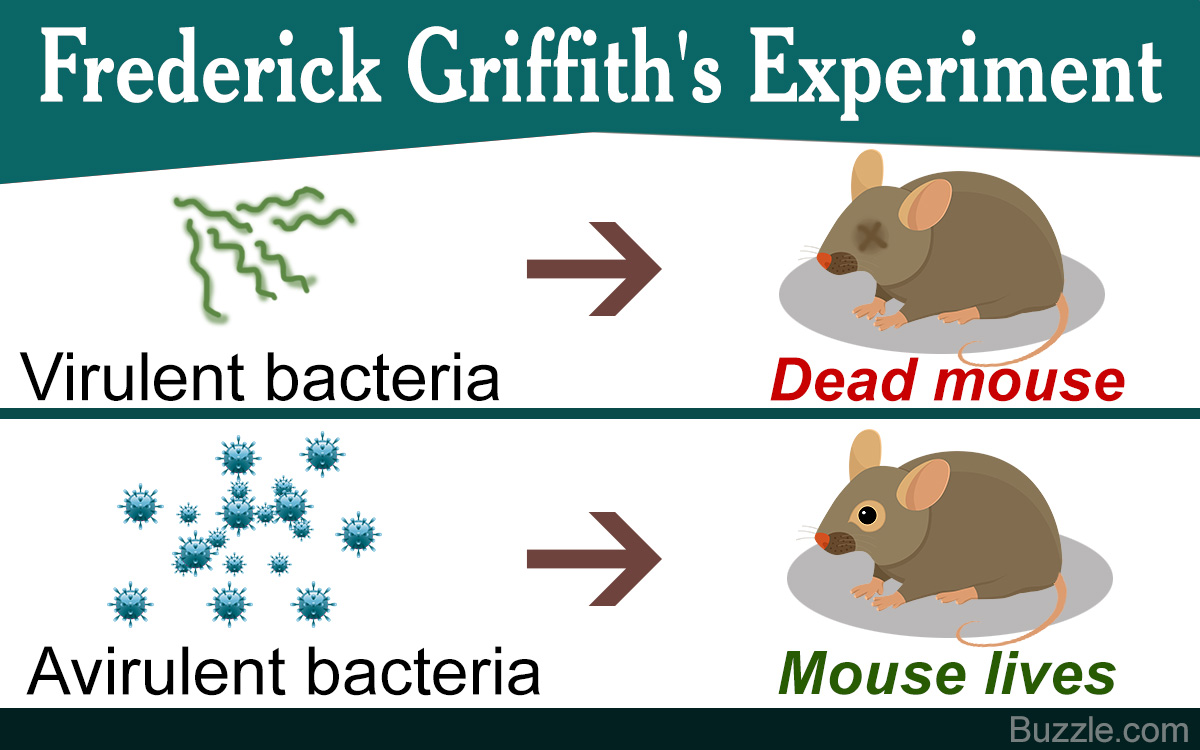
Did You Know?
Other processes by which exogenous genetic material is taken up by a cell include conjugation (transfer of DNA between two bacterial cells that are in direct contact) and transduction (injection of viral DNA by a bacteriophage into the host bacterial cell).
The post-World War I Spanish influenza pandemic influenced Frederick Griffith to study the epidemiology and pathology of bacterial pneumonia in order to attempt creating a successful vaccine. Hence, he carried out experiments, where he injected mice with strains of virulent and avirulent Streptococcus pneumoniae. The experiment he reported in 1928, gave the first description of the phenomenon of transformation, where one bacterial strain could change into the other strain, and this activity was linked to an unidentified element called the transforming factor or transforming principle.
Oswald T. Avery, an American pneumococcal researcher, speculated that Griffith’s experiment lacked appropriate control. However, subsequent, similar experiments carried out in Avery’s laboratory confirmed Griffith’s discovery. The experiments conducted later by Avery, MacLeod, and McCarty, and by Hershey and Chase proved that the transforming factor was DNA and elucidated its exact nature. Thereby, establishing the central role of DNA in inheritance.
Frederick Griffith’s Experiment

For his experiments, Griffith used two strains of Streptococcus pneumoniae that affected mice – type III S (smooth) and type II R (rough). The type III S form has a smooth appearance due to the presence of a polysaccharide layering over the peptidoglycan cell wall of the bacterial cell. This extra coating helps the cell in evading the phagocytosis carried out by the immune cells of the host; hence, allowing the strain to proliferate and become virulent.
In contrast, the type II R form lacks this coating, and hence, has a rough appearance. The absence of the polysaccharide layer leads to its efficient elimination by the host’s immune cells rendering the strain avirulent. While injecting the mice with these bacteria, Griffith devised four sets of inoculation that are as follows:
Type III S bacteria When the mice were inoculated, the bacterial virulence was exhibited, causing pneumonia, and this eventually led to the death of the mice. On examining the blood of the deceased mice, progeny of the inoculated cells were obtained.
Type II R bacteria When injected into the mice, the bacterial cells were successfully eliminated by the immune system, and hence, the mice lived. The blood showed no presence of the inoculated cells.
Type III S heat-killed bacteria When the virulent strain was rendered avirulent by heating and killing it (heat-killed), and then injected into the mice, the strain did not show virulence, and was eliminated by the host’s immune system; hence, the mice survived. Their blood showed no presence of the inoculated cells.
Type II R bacteria + Type III S heat-killed bacteria Injecting the mice with a combination of equal number of cells of type II R strain and heat-killed type III S strain, caused pneumonia which progressed till the mice died. The bacterial cells isolated from the blood of these mice showed the presence of live type III S bacterial cells.
This indicated that the live R strain had assimilated and incorporated the virulent element from the heat-killed S strain in order to transform itself into the virulent S strain. Based on this observation, Griffith concluded that a transforming element from the heat-killed strain was accountable for the transformation of the avirulent strain into the virulent strain. Successive experiments carried out in 1944 by Oswald Avery, Colin MacLeod, and Maclyn McCarty, proved that the element taken up by the harmless strain was genetic in nature.
Concept of Transformation
Transformation is a stable genetic change brought about by the uptake of naked DNA, and the state of being able to take up exogenous DNA is called competence. They occur in two forms―natural and artificial.
Natural Transformation
Only 1% of the bacterial species is capable of taking up DNA. Bacteria also exchange genetic material through a process called horizontal gene transfer, where bacterial cells conjugate and form a bridge via which the genetic material is transferred from one cell to another. A few bacterial species also release their DNA via exocytosis on their death, and this DNA is later taken up by the bacterial cells present in the vicinity. While transformation can occur between various bacterial species, it is most efficient when occurring between closely related species. These cells possess specific genes that code for natural competence allowing them to transport the DNA across the cellular membrane and into the cell. This transport involves the proteins associated with the type IV pili and type II secretion system as well as the DNA translocase complex at the cytoplasmic membrane.
This mechanism differs slightly due to the difference in the structure of the cell membranes of the bacteria. Bacteria are broadly classified into two types based on this difference – Gram-negative and Gram-positive. The general outline is more or less similar. The presence of exogenous DNA is detected by the cell and natural competence is induced, then the foreign DNA binds to a DNA receptor on the surface of these competent cells. This receptor binding allows the activation of the DNA translocase system that allows the passing of DNA into the cell via the cell membrane. During this process, one strand of the DNA is degraded by the action of nucleases. The translocated single strand is then incorporated into the bacterial genome via the help of a RecA-dependent process.
Gram-negative bacteria show the presence of an extra membrane, hence, for DNA to be taken up, a channel is formed on the outer membrane by secretins. The uptake of a DNA fragment is generally not specific to its sequence; however, in some bacterial species, it has been seen that the presence of certain DNA sequences facilitate and enhance efficient uptake of the genetic material.
Artificial Transformation
It is carried out in laboratories in order to carry out gene expression studies. To impart competence, the cells are incubated in a solution containing divalent cations (calcium chloride) under cold conditions, and then, exposed to intermittent pulses of heat. The concentration of the solution depends on the protein and liposaccharide content of the membrane, and the intensity of the heat pulses varies according to the time duration of the pulses, i.e., high intensity pulses should be for very short periods; whereas, low intensity pulses can be for longer durations.
The divalent cations function to weaken the molecular structure of the cell membrane, hence, making it more permeable. The subsequent heat pulses cause the creation of a thermal imbalance, and in the process of regaining balance, the DNA molecules gain entry via the weakened membrane and into the cell.
Artificial competence can be alternatively induced and promoted via the use of a technique called electroporation. It involves applying an electric current to the cell suspension. This causes the formation of pores in the cell membrane. The exogenous DNA is taken up via these holes, which are resealed via the cell membrane repair machinery.

Saccharomyces cerevisiae can be transformed by exogenous DNA using various methods. Yeast cells are treated with certain digesting enzymes that degrade the cell walls. This yields naked cells (devoid of cell wall) called spheroplasts. They are extremely fragile but have a high frequency of foreign DNA uptake.
Another method that can be used is, exposing the cells to alkaline cations such as lithium (from lithium acetate) and PEG. The PEG helps in pore formation, and the cations in the transport of the DNA fragment inside the cell.
The process of electroporation can also be used for transformation purposes, and efficiency can be enhanced using enzymatic digestion or agitation using glass beads.
The most common method of transforming plant cells is the Agrobacterium mediated transfer. In this method, the tissue of cells to be transformed is cut up into small uniform pieces, and then, treated with a suspension containing Agrobacterium. The foreign DNA gains entry via the cuts on the tissue, and the wound healing compounds secreted from the cuts, activate the virulence operon of the Agrobacterium. his causes the Agrobacterium. to infect the tissue and carry out its normal action of tumor induction. This function allows the transformed plant cells to proliferate. The cells are grown on a selective media till the transformed cells grow into plantlets with shoots and roots. They are then planted in soil and allowed to grow naturally.
Plant cells can also be transformed using viral particles (transduction). Here, the genetic material to be inserted is packaged into a suitable plant virus. This modified virus is then allowed to infect the plant cells. The transfer occurs according to the viral machinery and transformation is achieved. Electroporation can also be used for plant cells.
Introduction of foreign DNA into animal cells is conducted using viral or chemical agents like the ones used in case of plant and bacterial cells. However, since the term transformation is also used to refer to the progression of cancerous growth in animals, here, the term transfection is used.
This concept and technique has seen varied applications in the field of molecular biology with respect to expression studies, gene knockout studies, and cloning experiments. It is also used in the production of genetically modified organisms.
Get Updates Right to Your Inbox
Privacy overview.
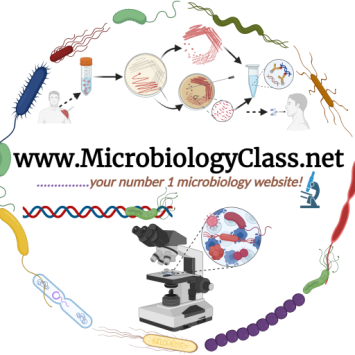
Lessons and Courses on Microbiology
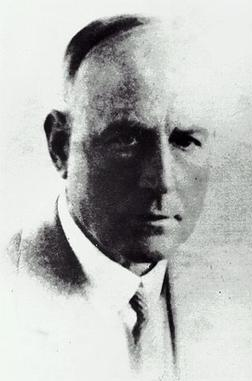
FREDERICK GRIFFITH (1879-1941)
Frederick Griffith was a British bacteriologist who performed transformation experiments that suggested that DNA was the hereditary material. His focus was on the epidemiology and pathology of bacterial pneumonia – which led him to develop the principle of bacterial transformation – which allow scientist to transform a bacterium through the introduction of exogenous DNA carrying the gene of interest.
Frederick showed that streptococcus pneumonia could transform from one strain into a different strain, an effect he attributed to an unidentified transforming principle or transforming factor . In 1928, Frederick reported what is now known as Griffith’s Experiment , which was the first widely accepted demonstration of bacterial transformation.
Frederick’s student, Avery Oswald , later demonstrated this principle of bacterial transformation conclusively. Frederick Griffith’s work established the foundation of molecular genetics, a field which is thriving today in the biomedical, biological and medical sciences.
His work showed that DNA is the genetic material.
Barrett J.T (1998). Microbiology and Immunology Concepts. Philadelphia, PA: Lippincott-Raven Publishers. USA.
Beck R.W (2000). A chronology of microbiology in historical context. Washington, D.C.: ASM Press.
Nester E.W, Anderson D.G, Roberts C.E and Nester M.T (2009). Microbiology: A Human Perspective. Sixth edition. McGraw-Hill Companies, Inc, New York, USA.
Salyers A.A and Whitt D.D (2001). Microbiology: diversity, disease, and the environment. Fitzgerald Science Press Inc. Maryland, USA.
Slonczewski J.L, Foster J.W and Gillen K.M (2011). Microbiology: An Evolving Science. Second edition. W.W. Norton and Company, Inc, New York, USA.
Summers W.C (2000). History of microbiology. In Encyclopedia of microbiology, vol. 2, J. Lederberg, editor, 677–97. San Diego: Academic Press.
Talaro, Kathleen P (2005). Foundations in Microbiology. 5 th edition. McGraw-Hill Companies Inc., New York, USA.
Share this:
Discover more from #1 microbiology resource hub.
Subscribe to get the latest posts to your email.
Type your email…
Related Posts

Introduction to (Medical) Bacteriology

Microbial Growth
Leave a reply cancel reply.
Subscribe now to keep reading and get access to the full archive.
Continue reading
Rethink Biology Notes
Ace the biology exams with expert notes
Griffith’s Experiment
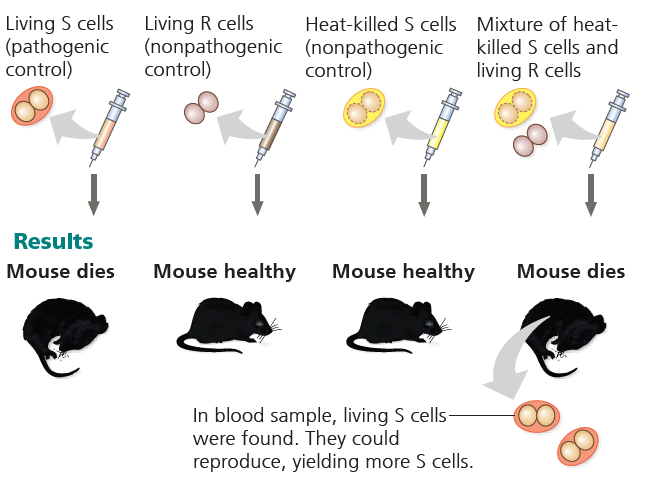
Table of Contents
Introduction:
- Experiment conducted by Frederick Griffith in 1928
- First experiment to demonstrate genetic material transfer between bacteria
- Laid foundation for discovery of DNA as genetic material and paved way for molecular biology
The Experiment:
- Involved two strains of Streptococcus pneumoniae bacteria: virulent (S) and non-virulent (R)
- Virulent strain caused pneumonia and had a smooth appearance due to polysaccharide capsule
- Non-virulent strain had a rough appearance
Steps of Experiment:
- Mice were injected with virulent strain and they died
- Mice were injected with a mixture of virulent and non-virulent strains and they did not die
- The non-virulent strain had transformed into the virulent strain
- Autopsy showed that the non-virulent bacteria had taken up the virulence factor (polysaccharide capsule) from the dead virulent bacteria
- Further experiments showed that a substance from the dead virulent bacteria (now called the transforming principle) was responsible for the transformation
- The transforming principle was later identified as DNA.
Conclusion:
- The experiment demonstrated that genetic material (DNA) could be transferred from one organism to another
- The experiment was a key step in the discovery of DNA as the genetic material
- The experiment paved the way for the development of molecular biology and genetic engineering.
Check out our Latest Posts
- Applications of Light Microscopy
- Applications of Atomic Force Microscopy
- Atomic Force Microscopy
- Transmission Electron Microscope (TEM)
- Scanning Electron Microscope (SEM)

IMAGES
VIDEO
COMMENTS
Griffith experiment was a stepping stone for the discovery of genetic material. Frederick Griffith experiments were conducted with Streptococcus pneumoniae. During the experiment, Griffith cultured Streptococcus pneumoniae bacteria which showed two patterns of growth.
Griffith's experiment, [1] performed by Frederick Griffith and reported in 1928, [2] was the first experiment suggesting that bacteria are capable of transferring genetic information through a process known as transformation.
In 1928, British bacteriologist Frederick Griffith conducted a series of experiments using Streptococcus pneumoniae bacteria and mice. Griffith wasn't trying to identify the genetic material, but rather, trying to develop a vaccine against pneumonia. In his experiments, Griffith used two related strains of bacteria, known as R and S. R strain.
Frederick Griffith (born October 3, 1877, Eccleston, Lancashire, England—died 1941, London) was a British bacteriologist whose 1928 experiment with bacterium was the first to reveal the “transforming principle,” which led to the discovery that DNA acts as the carrier of genetic information.
In England, microbiologist Frederick Griffith was studying two strains of Streptococcus pneumoniae that varied dramatically in both their appearance and their virulence, or their...
Figure 1: Griffith's experiments on pneumococci. The scientist Frederick Griffith observed that a living non-virulent bacterial strain could be transformed into a virulent strain after it was...
Griffith's Experiment was an experiment done in 1928 by Frederick Griffith. It was one of the first experiments showing that bacteria can get DNA through a process. Griffith used two strains of Streptococcus pneumoniae .
Transformation is a molecular biology mechanism via which foreign and exogenous genetic material is taken up by a cell and incorporated into its own genome. This phenomenon was first described and discovered by British bacteriologist, Frederick Griffith.
Frederick Griffith was a British bacteriologist who performed transformation experiments that suggested that DNA was the hereditary material.
Introduction: Experiment conducted by Frederick Griffith in 1928. First experiment to demonstrate genetic material transfer between bacteria. Laid foundation for discovery of DNA as genetic material and paved way for molecular biology.